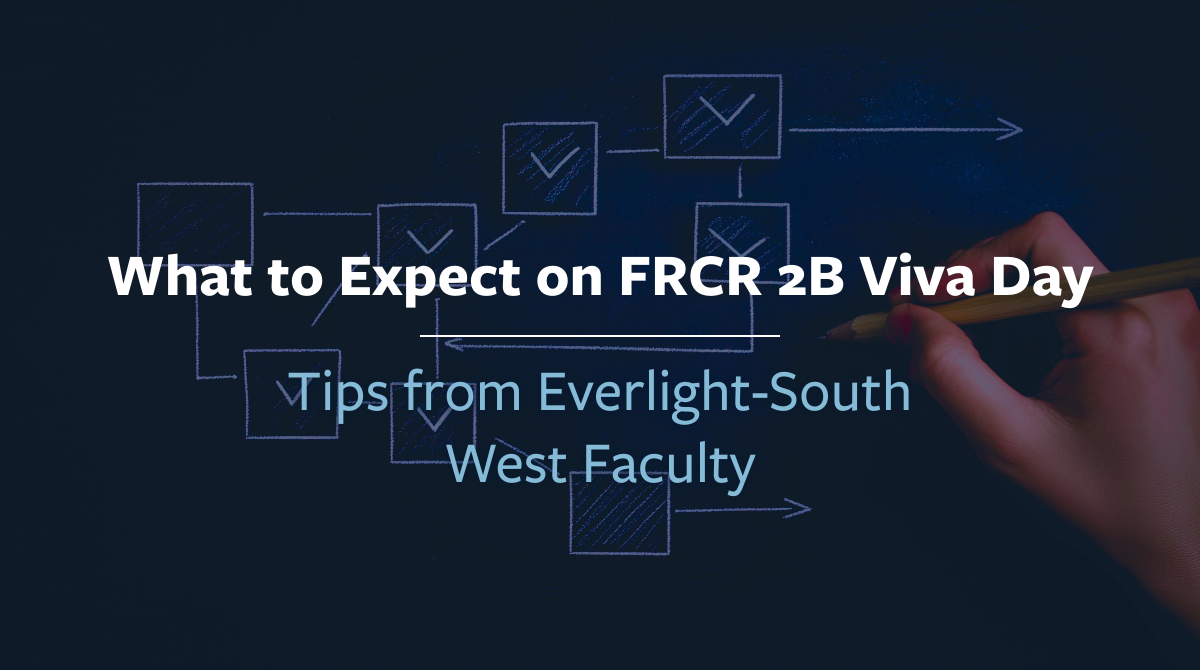
What to Expect on FRCR 2B Viva Day: Tips from Everlight-South West Faculty

Revise Radiology
June 17th, 2025
For many radiology trainees, the FRCR 2B Viva exam represents the culmination of years of study and clinical training. But even with a solid understanding of radiology, the experience of viva day can be daunting. In a recent Everlight–South West FRCR 2B course introduction, senior examiners, including Dr Dan, offered practical and honest advice to help candidates walk in prepared—not just intellectually, but mentally and emotionally.
Here are the key takeaways every candidate should keep in mind.
🎯 The Real Viva Is Different from the Course
“It is very intimidating,” said Dr Dan. Unlike the encouraging and supportive environment of the course, the real exam day carries an undeniable sense of formality.
You’ll likely wait outside the college building, surrounded by others dressed in suits and visibly nervous, revising from flashcards.
The environment is more rigid, and the examiners are focused, tired, and under pressure to mark fairly and consistently.
Don’t expect a warm or chatty tone—that’s normal.
🧠 Tip: Mentally rehearse being in that high-pressure setting. Expect fewer smiles and more silence.
🧍♂️ The Importance of a Confident Opening and Closing
One consistent message across all the faculty was this: start strong and finish clearly.
“Examiners are looking for a confident opening… and there must be a conclusion at the end,” said Dr Dan.
You are expected to:
Clearly signal when your presentation begins.
Deliver a focused and relevant image interpretation.
End with a diagnosis and management plan, just like you would in a multidisciplinary team (MDT) meeting.
🧠 Tip: Think of the examiner like a clinician at an MDT. They won’t understand your interpretation unless you summarise the findings and say what needs to happen next.
🧑⚕️ What Examiners Are Really Looking For
Several examiners echoed the same criteria:
Are you a safe radiologist?
Can you handle clinical questions logically?
Are you meticulous and thorough, yet efficient?
Can you communicate clearly and concisely?
Dr Iqbal noted that the goal is not just technical accuracy, but the ability to manage real-life reporting scenarios and liaise with clinicians effectively.
💬 Present Like a Consultant (But Speak Like a Trainee)
Dr Sudeep and Dr Dan reinforced the need for a crisp and to-the-point delivery.
Avoid rambling or getting lost in differential lists.
Speak with clarity, purpose, and direction.
Keep it professional and formal—don’t rely on examiner prompts to guide you to the answer.
Dr Nair reminded candidates not to expect the “friendly” prompting style seen during the course. In the real exam, you’re on your own—and that's by design.
😓 It’s Tough—for You and the Examiners
One of the most honest observations came from Dr Balasubramaniam:
“This is a new format—for the candidates and the examiners. There’s going to be stress on both sides.”
Fatigue builds over the course of the exam. If you're scheduled in the latter half of the session, you may feel the examiners are less responsive or less encouraging. Don’t take it personally. Their goal is still fairness—but human factors are real.
🧠 Tip: Prepare for your viva session as if you're going into an intense clinical meeting. Stay sharp and keep your tone measured and professional.
✅ Final Takeaways for Viva Success
✔ Practise presenting cases aloud
✔ Open with clarity; close with a clear diagnosis and plan
✔ Maintain formality—this is a professional setting
✔ Don’t expect encouragement—deliver your best regardless
✔ Internalise the pressure so it doesn’t rattle you on the day
🎓 “You’re Ready—Just Refine the Edges”
The feedback from the course was overwhelmingly positive. As Dr Dan put it:
“You guys are showing really good knowledge… some phenomenal pickups… If we can get just a bit better in those presentational aspects, there’s no doubt you’ll do well.”
You’ve done the work. Now it’s about polishing your presentation and preparing for the psychological setting of the real thing.
